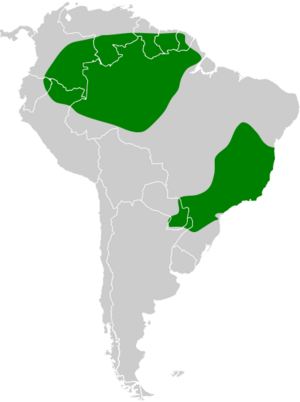Rusty-breasted nunlet facts for kids
Quick facts for kids Rusty-breasted nunlet |
|
|---|---|
 |
|
| Conservation status | |
| Scientific classification | |
| Genus: |
Nonnula
|
| Species: |
rubecula
|
 |
|
The rusty-breasted nunlet (Nonnula rubecula) is a small, quiet bird found in the forests of South America. It belongs to a bird family called Bucconidae. This family includes puffbirds, nunlets, and nunbirds. These birds are known for often sitting very still, which can make them hard to see! You can find the rusty-breasted nunlet in countries like Argentina, Brazil, Colombia, and Peru.
Contents
Bird Families: Taxonomy
Scientists group living things into families and species. This helps them understand how different animals are related. This grouping is called taxonomy. For the rusty-breasted nunlet, scientists recognize seven different types, called subspecies. These subspecies are slightly different from each other.
Scientists are still learning about these birds. Some think that a few of these subspecies might actually be their own separate species. Others believe some types might not be different enough to be separate. It's like a big puzzle that scientists are still putting together!
- N. r. tapanahoniensis
- N. r. duidae
- N. r. interfluvialis
- N. r. simulatrix
- N. r. cineracea
- N. r. simplex
- N. r. rubecula
What Does the Rusty-breasted Nunlet Look Like?
The rusty-breasted nunlet is a small bird, about 14 to 16 cm (5.5 to 6.3 in) long. That's about the length of a pen! It weighs around 17 to 20 g (0.60 to 0.71 oz), which is lighter than a few coins.
The different subspecies have slightly different looks. Generally, the birds living further north have longer, narrower beaks and shorter tails. Those living further south have shorter beaks and longer tails.
The most common type, called the "nominate subspecies," can have a few different colors. Some of these birds have dark gray-brown backs and wings. They have reddish-brown patches near their eyes and a white ring around each eye. Their throat and chest are brownish with a reddish color, and their belly is whitish. Other birds of the same type can be paler or grayer. Some even have a bright orange-red throat and chest!
Other subspecies have their own unique touches. For example, N. r. tapanahoniensis has a very gray head. N. r. duidae has a reddish-brown chin. These small differences help scientists tell them apart.
Where Do Rusty-breasted Nunlets Live?
The rusty-breasted nunlet lives in two main areas that are far apart. Each subspecies lives in a specific part of these areas:
- N. r. tapanahoniensis: Found in the southern parts of The Guianas and northern Brazil.
- N. r. duidae: Lives in eastern Venezuela, north of the Orinoco River.
- N. r. interfluvialis: Found in southern Venezuela and northern Brazil, between the Orinoco and Negro rivers.
- N. r. simulatrix: Lives in southeastern Colombia and northwestern Brazil, between the Negro and Amazon rivers.
- N. r. cineracea: Found in northeastern Ecuador, northeastern Peru, and western Brazil.
- N. r. simplex: Lives in northern Brazil, south of the lower Amazon River.
- N. r. rubecula: Found in eastern and southeastern Brazil, eastern Paraguay, and northeastern Argentina.
These birds mostly live in humid forests. They prefer forests on dry land (called terra firme) and forests that sometimes flood (called várzea). You can also find them in younger forests that are growing back or at the edges of forests. They can be anywhere in the forest, but they are most often seen in the middle layers of trees.
Rusty-breasted Nunlet Behavior
Feeding Habits
The rusty-breasted nunlet mainly eats large arthropods. These are creatures like insects and spiders. They eat both adult insects and their young (larvae). Sometimes, these nunlets will briefly join groups of different bird species that are looking for food together.
Reproduction and Nests
For a long time, people thought rusty-breasted nunlets nested in burrows in the ground. But in 2020, scientists discovered something new! They found that these birds build their nests in a shallow dip on sloped ground. They then cover the nest with twigs and leaves to make a roof.
Scientists studied 17 nests in Argentina over seven years. Most nests had four eggs, but one had three. Both the male and female birds help out. They take turns sitting on the eggs to keep them warm. They also work together to feed the baby birds once they hatch.
Bird Calls and Songs
The rusty-breasted nunlet's song sounds like a series of "weeip, weeip, weeip" notes. It can sing up to 20 of these notes in a row. The song starts quietly and low, then gets louder and higher in pitch. However, these birds do not sing very often.
Conservation Status
The IUCN (International Union for Conservation of Nature) has looked at the rusty-breasted nunlet. They have listed it as a species of "Least Concern." This means it is not currently considered endangered or at high risk of disappearing.
The bird lives in a very large area. However, scientists don't know exactly how many rusty-breasted nunlets there are. They believe the total number of these birds might be going down. In some places, they seem rare, while in others, they are quite common. It can be hard to count them because they are so quiet and don't draw much attention to themselves. Luckily, they live in several protected areas, which helps keep their habitats safe.


